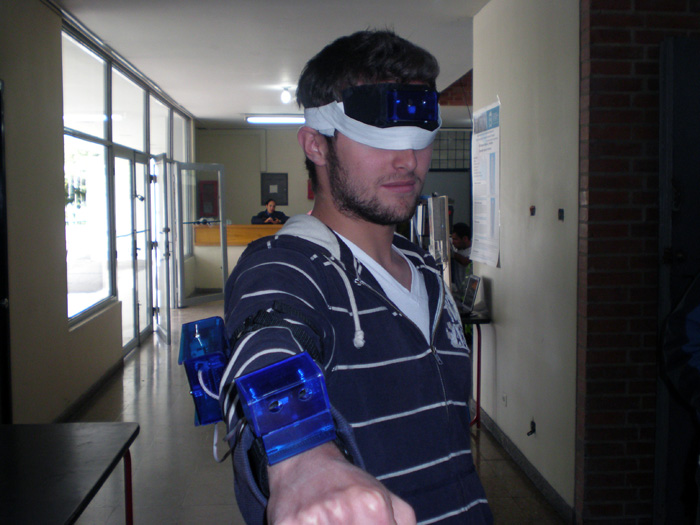The equipment is made up of two separate devices. The first one detects objects suspended in the air and has a frontal range of 31.5 inches (80 centimeters). A bracelet and two elastic bands "one goes around the head and the other around the wrist " support infrared sensors protected by an acrylic casing.
The wrist"s dispositive range is from about 4 foot and 11 inches (150 centimeters) and is composed by a minuscule black box where the alert system treats the signal and emits vibrations.
The second device measures and detects obstacles at a ground level. It contains two acrylic boxes storing the batteries. The electronic components card processes the signal received by the sensor and triggers an eccentric mass vibrator.
"The dispositive was created after a survey among blind persons. They told us about their need for a more secure tool, and showed interest at our idea of creating a prototype that would detect suspended objects", said Lina María Gallegos. Together with Juan Manuel Fonseca and Alfonso Castro, they created this revolutionary implement, more affordable if compared to equivalent systems.
The sensor sends a light signal in order to measure the distance to the obstacle. When an object is on the way it reflects the light, then the photoreceptor receives the signal back. Depending on the distance to the obstacle, an alert is generated through a microcontroller activating a high speed motor."
Changing the Habits
According to Olga Lucía Ruiz, from the National Institute for the Visually Impaired (INCI), "The traditional stick has been working for centuries", that"s why there will be an important resistance against the new dispositive. In addition, the stick works as well as a self-defense weapon.
According to Gallegos, it is clear that their proposal requires a learning curve, which would take some time: "we know that when people lose their vision, they take between three and six months to get used to the stick.
The prototype integrates an education program and sensitivity training. The user needs to become accustomed with the system, particularly with the vibration levels."When we tried it for the first time, we realized that reflections have an important role preventing the user in time to react safely", said Gallego.
"Our equipment is the smallest among the ones produced in the country, and is equipped with easy-to-use microcontrollers for signal processing", said the engineer.
The innovative obstacle detector developed by this UN engineer group has plenty of advantages. Not only it guides the user in a safe and easy way, but is lightweight and affordable.
 Correo Electrónico
Correo Electrónico
 DNINFOA - SIA
DNINFOA - SIA
 Bibliotecas
Bibliotecas
 Convocatorias
Convocatorias
 Identidad UNAL
Identidad UNAL



